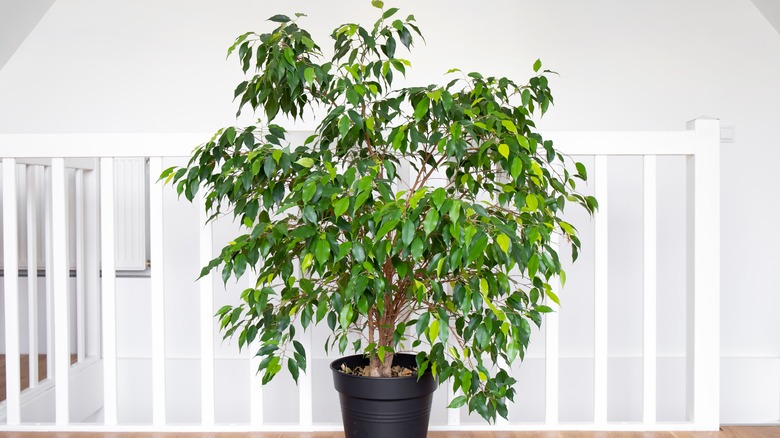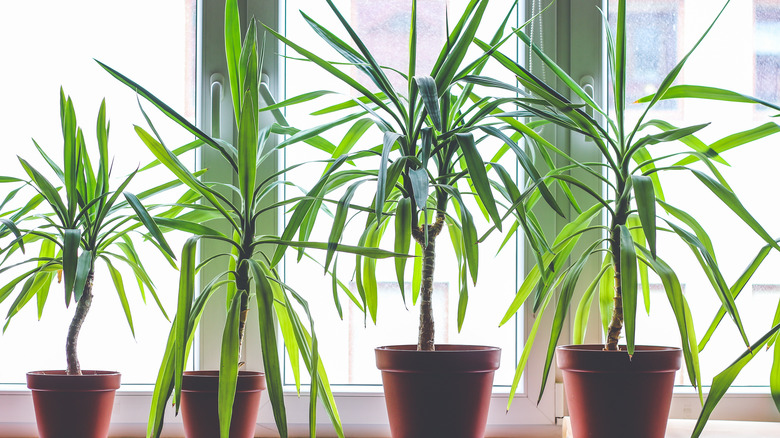Why A Ficus Might Not Be The Ideal Houseplant
There are many types of ficus trees and shrubs, many of which are recommended for beginner gardeners because they're the kinds of houseplants almost anyone can keep alive. Moreover, the ficus was named in a 1989 NASA study involving the ability of houseplants to remove pollutants from the air, making it seem like a positive wellness choice too. However, the National Institute of Health noted in 2001 that the ficus benjamina in particular (also known as the weeping fig) was an established source of allergic reactions, including skin irritation and mild respiratory distress, and concluded in no uncertain terms that the plant should not be used for your indoor greenery at work or at home. Asthma sufferers, people with sensitivities to latex, and others with pollen allergies should keep away.
Stylistically, it's easy to see why the ficus is a popular houseplant for its versatility, affordability, and ease of care. For a lot of indoor gardeners these days, there's also a strong element of nostalgia attached to the tree. A staple of indoor '70s and '80s greenery, the ficus tree is associated with a lot of happy formative memories for newer homeowners looking to build their personal interior style. The weeping fig's bright, teardrop-shaped leaves and braided trunk also make for a beautiful statement plant. Unfortunately, that beauty can be hiding some unhealthy risks that you might not even be aware you're sensitive to.
Dust mites and the hidden dangers of latex
The weeping fig type of ficus harbors a great deal of dust in its leaves, making it a potential threat to anyone with seasonal allergies or sensitivities to dust, as well as those with asthma or other respiratory diseases. While the ficus can and should be dusted regularly, this is not an adequate way to prevent the irritation it can cause. Pollen and other such allergens in the air can trigger more frequent asthma attacks, or even exacerbate them, which may result in hospitalization. And even for mild hay fever sufferers, the constant presence of itchy, watery eyes and inflamed sinuses is not a pleasant way to live.
Moreover, the proteins present in the leaves and sap of the ficus are very similar to latex proteins. An allergic reaction to latex can consist of a mild skin reaction like an itchy rash or hives, or may be as severe as an inability to breathe or even anaphylactic shock. And since latex allergies tend to develop over time, the more you're exposed to latex, having a ficus benjamina in your home would greatly increase the possibility of developing such a sensitivity. Latex allergies aren't exclusive to humans, either. Your pets could be at risk as well, particularly if you have dogs. In short, the indoor ficus is simply not worth the risk of harming the health of you or the others in your household.
Plants that clear the air
There are several types of houseplants that are actually recommended for allergy sufferers because of their ability to purify the air. The areca palm, for example, is another potted tree, like the ficus, but it's a natural humidifier that will help balance out a home where the air is dry. Additionally, members of the Dracaena family –- such as dragon tree, snake plant, lucky bamboo, and more –- are some of the best houseplants for people with allergies. They absorb pollutants into their foliage and root systems, then release clean, fresh oxygen as part of their photosynthesis process.
With regard to latex allergies, only about 10% of flowering plants produce the substance, but that still comes to over 20,000 species across 40 families. Still, it's probably easier to know what to avoid, which, when it comes to houseplants, includes any kind of ficus (fig tree), poinsettias, and the toxic oleander. Stick to a golden pothos or a lovely peace lily instead, and breathe easier in more ways than one.


